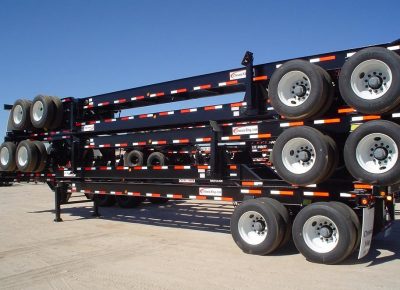A current issue that many supply chain and logistics companies are experiencing is a shortage is chassis. The first question to ask here is, why are we experiencing a shortage of chassis? The shortage of chassis has been intensified from the pandemic and has since created new challenges. While some of the primary reasons are due to an increase in freight volume, chassis that get displaced as well as U.S tariffs and the difficulty in locating components needed to build new chassis. This is creating an issue as many of these supply chain companies are unable to locate and purchase chassis to keep up with the needs of their customer’s demand. Looking back on the year of 2021, showed that with the struggles of having to import chassis from China became increasingly difficult due to the federal ban on completing the imports which forced manufactures to try and pick up the pieces and rectify the situation.
With the domestic manufactures now working diligently to try and locate chassis from other areas it was initially predicted that the shortage of chassis would have been resolved mid-2022, however it appears that domestic chassis manufactures are still struggling to keep up with the demand for the chassis. As it was explained in the Journal of Commerce “North American chassis manufacturers have run into production delays in 2022 for the second consecutive year, slowed by difficulties in sourcing raw components and retaining factory workers, which means widespread shortages of marine chassis may persist until 2024.” What this means for supply chain departments is that the number of chassis that were ordered initially is increasingly less than what is currently needed. Even with having these numbers of chassis ordered, the specific figures on the US chassis fleet are not readily available so it will be hard to predict how long it will take to be out of the current shortage phase and have easy access to chassis again. It is predicted that the chassis that were ordered this year are expected to be delivered sometime in 2023 and chassis orders placed in 2023 will arrive in 2024.
It looks like it may not be until 2024 where orders placed can be delivered in the same calendar year. On top of the shortage of domestic chassis manufactures, it has become increasingly difficult to have marine chassis made internationally because the government advised it would prefer it be made there. Chassis manufactures advised that to made a single chassis can require material from anywhere from 20-30 different suppliers. It can be quite complicated to obtain specific materials from so many suppliers and often some of these suppliers are unable to meet the demand that is required to produce the number of chassis that are requested. Parts such as axles, air tanks and suspension systems are experiencing setbacks to acquires these and it has factored in the delay of ordered chassis. Another issue that can lead to the shortage in chassis is the difficulty of retaining factory workers. Ever since Covid-19 happened there has been difficulty in obtaining new workers who manage to last past their initial training. To try and stay ahead of the chassis shortage, we need to ask how we can successfully manage the crisis of shortages in chassis. The most effective way to manage the shortage of chassis is by creating a plan with key points to help overcome the shortage of chassis. Enforcing an up-to-date maintenance and repair report. If this is completed it will help manage and keep track of deactivated chassis and possibly open more room to have the capacity to build more chassis to try and prevent future shortages.
Another key opportunity to best manage the chassis crisis by offering incentives to shippers who return the chassis as scheduled. While the lack of chassis is clearly a big issue, factors like chassis displacements and services can negatively affect the number of readily available chassis. If an incentive plan was issued it would prompt shippers to return chassis earlier and help assist with coordinating upcoming loads and allow for drayage providers the chance to reuse these chassis for priority cargo which will ultimately help improve movement of containers throughout various logistics hubs. While the current shortage and delay in chassis has created many issues, they can be resolved by utilizing a plan of current maintenance and repair, and creating different incentives to prompt these shippers to return the chassis quickly. While this plan will help to have chassis returned quickly, unfortunately people are still without them and may continue to be more the next year, year and a half as the current chassis shortage is behind high demurrage charges and leads to delayed deliveries.


